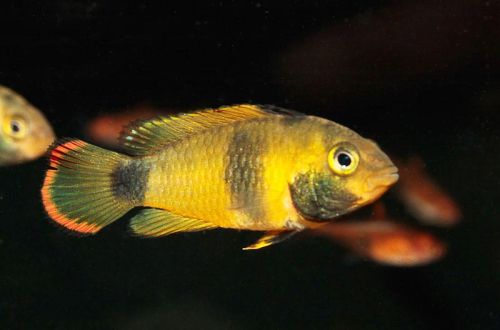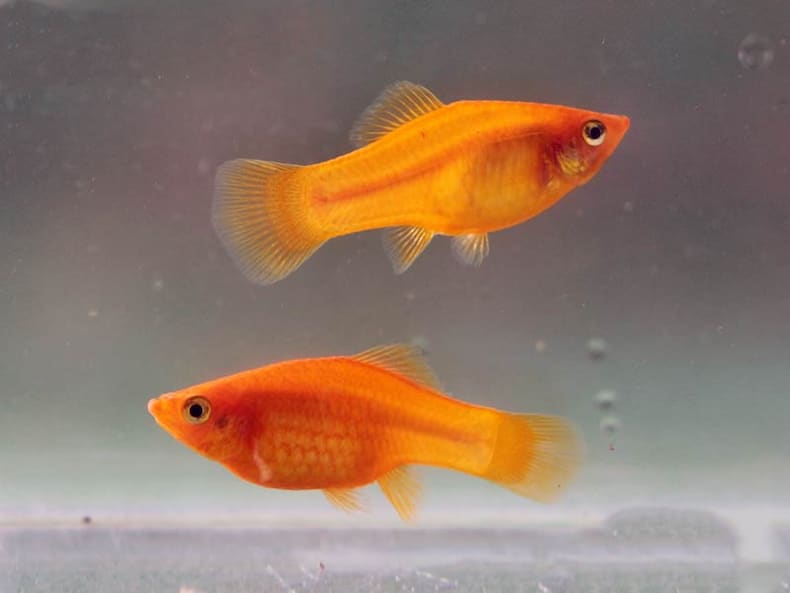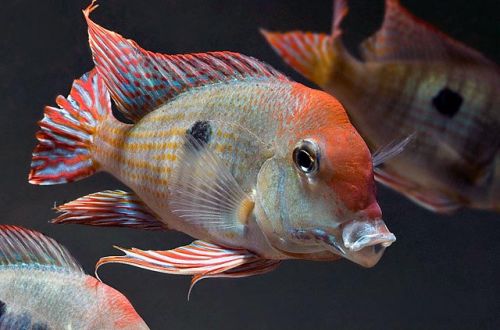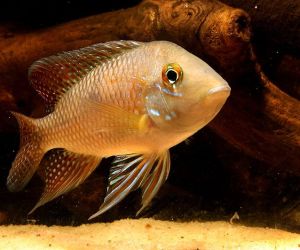
Apistogramma panda
Panda Apistogramma or Panda Cichlid, scientific name Apistogramma nijsseni, belongs to the Cichlidae family. Beautiful, relatively peaceful fish. Difficulties in keeping for an aquarist can be caused by the need for fish in live food and the maintenance of hydrochemical parameters in a rather narrow acceptable range of values.

Contents
Habitat
It comes from South America from a limited area of the basins of the Ucayali and Yavari rivers in the territory of modern Peru. It lives mainly in small tributaries, streams, in which the water is colored dark brown due to the abundance of dissolved tannins released during the decomposition of plant organic matter. A dense canopy of tropical tree crowns prevents light from reaching the surface of the water, and the bottom of the rivers is littered with fallen trees, branches and a layer of rotting leaves.
Brief information:
- The volume of the aquarium – from 60 liters.
- Temperature – 24-28°C
- Value pH — 5.0–6.5
- Water hardness – very soft (1-5 dGH)
- Substrate type – sandy
- Lighting – subdued
- Brackish water – no
- Water movement is weak
- The size of the fish is 7–8 cm.
- Nutrition – meat feed
- Temperament – peaceful, except during spawning periods
- Keeping in a group with one male and several females
Description

Adults reach a length of about 7–8 cm. Males are larger and more colorful than females. The color is dominated by yellow and black tones with a bluish tint. The fins are yellow, the tail has an orange edging and a rounded shape, not characteristic of most cichlids.
Food
Belongs to carnivorous species, feeds on small aquatic insects and their larvae, benthic invertebrates. In the aquarium, it is also desirable to serve live (or frozen) food, such as brine shrimp, daphnia, bloodworms, mosquito larvae. Before purchasing fish, you should clarify what type of food they were fed. Perhaps they are accustomed to dry sinking food in the form of flakes or granules, which will greatly facilitate their maintenance.
Maintenance and care, arrangement of the aquarium
The optimal aquarium size for several Apistogramma Niissen starts at 60 liters. The design uses a sandy substrate, numerous shelters made of snags or other decorative items, thickets of shade-loving plants and clusters of vegetation floating on the surface. The lighting is subdued.
The composition of the water should have slightly acidic pH values and low carbonate hardness. Beech, oak, Indian almond leaves or special essences are usually added to give the water a brown tint characteristic of its natural habitat. The leaves are pre-dried, then soaked and only then placed in the aquarium. As they decompose, the water will become saturated with tannins and turn tea-colored.
Maintaining high water quality will require the installation of a productive filtration system with efficient biological treatment. Since filters are the main sources of internal flow, in this case they are installed in such a way as to minimize water movement, otherwise the fish will feel uncomfortable.
Behavior and Compatibility
Most of the fish for sale have been bred in the artificial environment of aquariums for many generations, which has affected their behavior. They have become less aggressive in defending their territory than their wild relatives. They get along well with other fish of similar size and temperament. However, during the spawning season, smaller neighbors may be attacked.
Breeding / breeding
Under favorable conditions (suitable hydrochemical composition and water temperature), the probability of the appearance of fry is very high, especially if live food is present in the diet. With the beginning of the mating season, the male can show signs of attention to several females at once, each of which will give offspring. In this case, it should be provided that the number of shelters coincides with the number of females, and they are located at a distance from each other.
During spawning, the female lays her eggs in safe shelters and remains near the clutch to protect her. When the fry appear, she will continue to take care of them, protecting them from strangers. The male is also involved in the protection of offspring, however, often he becomes overly aggressive and has to be temporarily relocated to a separate aquarium.
Fish diseases
The main cause of most diseases is unsuitable living conditions and poor-quality food. If the first symptoms are detected, you should check the water parameters and the presence of high concentrations of hazardous substances (ammonia, nitrites, nitrates, etc.), if necessary, bring the indicators back to normal and only then proceed with treatment. Read more about symptoms and treatments in the Aquarium Fish Diseases section.





